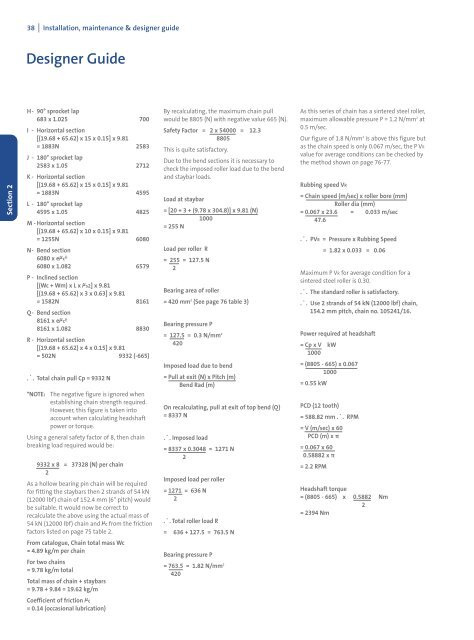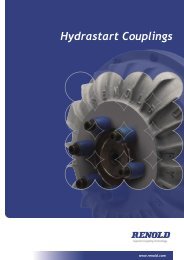Conveyor chain
Conveyor chain
Conveyor chain
Create successful ePaper yourself
Turn your PDF publications into a flip-book with our unique Google optimized e-Paper software.
Section 2<br />
38 I Installation, maintenance & designer guide<br />
Designer Guide<br />
H- 90° sprocket lap<br />
683 x 1.025 700<br />
I - Horizontal section<br />
[(19.68 + 65.62) x 15 x 0.15] x 9.81<br />
= 1883N 2583<br />
J-180° sprocket lap<br />
2583 x 1.05 2712<br />
K- Horizontal section<br />
[(19.68 + 65.62) x 15 x 0.15] x 9.81<br />
= 1883N 4595<br />
L- 180° sprocket lap<br />
4595 x 1.05 4825<br />
M - Horizontal section<br />
[(19.68 + 65.62) x 10 x 0.15] x 9.81<br />
= 1255N 6080<br />
N- Bend section<br />
6080 x eµ cθ 6080 x 1.082 6579<br />
P- Inclined section<br />
[(Wc + Wm) x L x µ s2] x 9.81<br />
[(19.68 + 65.62) x 3 x 0.63] x 9.81<br />
= 1582N 8161<br />
Q- Bend section<br />
8161 x eµ cθ 8161 x 1.082 8830<br />
R- Horizontal section<br />
[(19.68 + 65.62) x 4 x 0.15] x 9.81<br />
= 502N 9332 (-665)<br />
. . . Total <strong>chain</strong> pull Cp = 9332 N<br />
*NOTE: The negative figure is ignored when<br />
establishing <strong>chain</strong> strength required.<br />
However, this figure is taken into<br />
account when calculating headshaft<br />
power or torque.<br />
Using a general safety factor of 8, then <strong>chain</strong><br />
breaking load required would be:<br />
9332 x 8 = 37328 (N) per <strong>chain</strong><br />
2<br />
As a hollow bearing pin <strong>chain</strong> will be required<br />
for fitting the staybars then 2 strands of 54 kN<br />
(12000 lbf) <strong>chain</strong> of 152.4 mm (6'' pitch) would<br />
be suitable. It would now be correct to<br />
recalculate the above using the actual mass of<br />
54 kN (12000 lbf) <strong>chain</strong> and µ c from the friction<br />
factors listed on page 75 table 2.<br />
From catalogue, Chain total mass Wc<br />
= 4.89 kg/m per <strong>chain</strong><br />
For two <strong>chain</strong>s<br />
= 9.78 kg/m total<br />
Total mass of <strong>chain</strong> + staybars<br />
= 9.78 + 9.84 = 19.62 kg/m<br />
Coefficient of friction µ c<br />
= 0.14 (occasional lubrication)<br />
By recalculating, the maximum <strong>chain</strong> pull<br />
would be 8805 (N) with negative value 665 (N).<br />
Safety Factor = 2 x 54000 = 12.3<br />
8805<br />
This is quite satisfactory.<br />
Due to the bend sections it is necessary to<br />
check the imposed roller load due to the bend<br />
and staybar loads.<br />
Load at staybar<br />
= [20 + 3 + (9.78 x 304.8)] x 9.81 (N)<br />
1000<br />
= 255 N<br />
Load per roller R<br />
= 255 = 127.5 N<br />
2<br />
Bearing area of roller<br />
= 420 mm2 (See page 76 table 3)<br />
Bearing pressure P<br />
= 127.5 = 0.3 N/mm2 420<br />
Imposed load due to bend<br />
= Pull at exit (N) x Pitch (m)<br />
Bend Rad (m)<br />
On recalculating, pull at exit of top bend (Q)<br />
= 8337 N<br />
. . . Imposed load<br />
= 8337 x 0.3048 = 1271 N<br />
2<br />
Imposed load per roller<br />
= 1271 = 636 N<br />
2<br />
. . . Total roller load R<br />
= 636 + 127.5 = 763.5 N<br />
Bearing pressure P<br />
= 763.5 = 1.82 N/mm2 420<br />
As this series of <strong>chain</strong> has a sintered steel roller,<br />
maximum allowable pressure P = 1.2 N/mm2 at<br />
0.5 m/sec.<br />
Our figure of 1.8 N/mm2 is above this figure but<br />
as the <strong>chain</strong> speed is only 0.067 m/sec, the P VR<br />
value for average conditions can be checked by<br />
the method shown on page 76-77.<br />
Rubbing speed VR<br />
= Chain speed (m/sec) x roller bore (mm)<br />
Roller dia (mm)<br />
= 0.067 x 23.6 = 0.033 m/sec<br />
47.6<br />
. . . PVR = Pressure x Rubbing Speed<br />
= 1.82 x 0.033 = 0.06<br />
Maximum P VR for average condition for a<br />
sintered steel roller is 0.30.<br />
. . . The standard roller is satisfactory.<br />
. . . Use 2 strands of 54 kN (12000 lbf) <strong>chain</strong>,<br />
154.2 mm pitch, <strong>chain</strong> no. 105241/16.<br />
Power required at headshaft<br />
= Cp x V kW<br />
1000<br />
= (8805 - 665) x 0.067<br />
1000<br />
= 0.55 kW<br />
PCD (12 tooth)<br />
= 588.82 mm . . . RPM<br />
= V (m/sec) x 60<br />
PCD (m) x π<br />
= 0.067 x 60<br />
0.58882 x π<br />
= 2.2 RPM<br />
Headshaft torque<br />
= (8805 - 665) x 0.5882 Nm<br />
2<br />
= 2394 Nm




